The Effect of TGF-β3 and IL-1β on L-Type Voltage-Operated Calcium Channels and Calcium Ion Homeostasis in Osteoarthritic Chondrocytes and Human Bone Marrow-Derived Mesenchymal Stem Cells During Chondrogenesis
Abstract
1. Introduction
2. Materials and Methods
2.1. Cell Isolation and Culture
2.2. Chondrogenic Differentiation
2.3. Intracellular Calcium Levels
2.4. Gene Expression Analysis
2.5. Electrophysiological Recording
2.6. Statistical Analysis
3. Results
3.1. Modulation of Intracellular Calcium Ion Levels in Response to TGF-β3 and IL-1β
3.2. Inward L-Type Calcium Current in hBM-MSCs
3.3. Inward L-Type Calcium Current in Chondrocytes
3.4. Effect of TGF-β3 and IL-1β on CACNA1C and ATP2A2 Gene Expression
4. Discussion
Author Contributions
Funding
Institutional Review Board Statement
Informed Consent Statement
Data Availability Statement
Conflicts of Interest
References
- Tzavlaki, K.; Moustakas, A. TGF-β Signaling. Biomolecules 2020, 10, 487. [Google Scholar] [CrossRef]
- Mehlhorn, A.T.; Niemeyer, P.; Kaschte, K.; Muller, L.; Finkenzeller, G.; Hartl, D.; Sudkamp, N.P.; Schmal, H. Differential Effects of BMP-2 and TGF-Beta1 on Chondrogenic Differentiation of Adipose Derived Stem Cells. Cell Prolif. 2007, 40, 809–823. [Google Scholar] [CrossRef]
- Uzieliene, I.; Bagdonas, E.; Hoshi, K.; Sakamoto, T.; Hikita, A.; Tachtamisevaite, Z.; Rakauskiene, G.; Kvederas, G.; Mobasheri, A.; Bernotiene, E. Different Phenotypes and Chondrogenic Responses of Human Menstrual Blood and Bone Marrow Mesenchymal Stem Cells to Activin A and TGF-Β3. Stem Cell Res. Ther. 2021, 12, 251. [Google Scholar] [CrossRef]
- Futrega, K.; Robey, P.G.; Klein, T.J.; Crawford, R.W.; Doran, M.R. A Single Day of TGF-Β1 Exposure Activates Chondrogenic and Hypertrophic Differentiation Pathways in Bone Marrow-Derived Stromal Cells. Commun. Biol. 2021, 4, 29. [Google Scholar] [CrossRef]
- Mackay, A.M.; Beck, S.C.; Murphy, J.M.; Barry, F.P.; Chichester, C.O.; Pittenger, M.F. Chondrogenic Differentiation of Cultured Human Mesenchymal Stem Cells from Marrow. Tissue Eng. 1998, 4, 415–428. [Google Scholar] [CrossRef]
- Mueller, M.B.; Fischer, M.; Zellner, J.; Berner, A.; Dienstknecht, T.; Prantl, L.; Kujat, R.; Nerlich, M.; Tuan, R.S.; Angele, P. Hypertrophy in Mesenchymal Stem Cell Chondrogenesis: Effect of TGF-β Isoforms and Chondrogenic Conditioning. CTO 2010, 192, 158–166. [Google Scholar] [CrossRef]
- Mueller, M.B.; Tuan, R.S. Functional Characterization of Hypertrophy in Chondrogenesis of Human Mesenchymal Stem Cells. Arthritis Rheum. 2008, 58, 1377–1388. [Google Scholar] [CrossRef]
- Shen, B.; Wei, A.; Tao, H.; Diwan, A.D.; Ma, D.D.F. BMP-2 Enhances TGF-Beta3-Mediated Chondrogenic Differentiation of Human Bone Marrow Multipotent Mesenchymal Stromal Cells in Alginate Bead Culture. Tissue Eng. Part A 2009, 15, 1311–1320. [Google Scholar] [CrossRef]
- Huang, X.; Zhong, L.; Hendriks, J.; Post, J.N.; Karperien, M. Different Response of Human Chondrocytes from Healthy Looking Areas and Damaged Regions to IL1β Stimulation under Different Oxygen Tension. J. Orthop. Res. 2019, 37, 84–93. [Google Scholar] [CrossRef] [PubMed]
- Jenei-Lanzl, Z.; Meurer, A.; Zaucke, F. Interleukin-1β Signaling in Osteoarthritis—Chondrocytes in Focus. Cell. Signal. 2019, 53, 212–223. [Google Scholar] [CrossRef] [PubMed]
- Mohamed-Ali, H. Influence of Interleukin-1 Beta, Tumour Necrosis Factor Alpha and Prostaglandin E2 on Chondrogenesis and Cartilage Matrix Breakdown in Vitro. Rheumatol. Int. 1995, 14, 191–199. [Google Scholar] [CrossRef] [PubMed]
- Wehling, N.; Palmer, G.D.; Pilapil, C.; Liu, F.; Wells, J.W.; Müller, P.E.; Evans, C.H.; Porter, R.M. Interleukin-1 and Tumor Necrosis Factor-α Inhibit Chondrogenesis by Human Mesenchymal Stem Cells through NF-κB Dependent Pathways. Arthritis Rheum. 2009, 60, 801–812. [Google Scholar] [CrossRef]
- Remst, D.F.G.; Blaney Davidson, E.N.; Vitters, E.L.; Bank, R.A.; van den Berg, W.B.; van der Kraan, P.M. TGF-ß Induces Lysyl Hydroxylase 2b in Human Synovial Osteoarthritic Fibroblasts through ALK5 Signaling. Cell Tissue Res. 2014, 355, 163–171. [Google Scholar] [CrossRef]
- Yang, X.; Chen, L.; Xu, X.; Li, C.; Huang, C.; Deng, C.-X. TGF-β/Smad3 Signals Repress Chondrocyte Hypertrophic Differentiation and Are Required for Maintaining Articular Cartilage. J. Cell Biol. 2001, 153, 35–46. [Google Scholar] [CrossRef]
- Lu, L.; Wang, P.; Zou, Y.; Zha, Z.; Huang, H.; Guan, M.; Wu, Y.; Liu, G. IL-1β Promotes Stemness of Tumor Cells by Activating Smad/ID1 Signaling Pathway. Int. J. Med. Sci. 2020, 17, 1257–1268. [Google Scholar] [CrossRef] [PubMed]
- Blaney Davidson, E.N.; Remst, D.F.G.; Vitters, E.L.; van Beuningen, H.M.; Blom, A.B.; Goumans, M.-J.; van den Berg, W.B.; van der Kraan, P.M. Increase in ALK1/ALK5 Ratio as a Cause for Elevated MMP-13 Expression in Osteoarthritis in Humans and Mice1. J. Immunol. 2009, 182, 7937–7945. [Google Scholar] [CrossRef] [PubMed]
- Matta, C.; Fodor, J.; Szíjgyártó, Z.; Juhász, T.; Gergely, P.; Csernoch, L.; Zákány, R. Cytosolic Free Ca2+ Concentration Exhibits a Characteristic Temporal Pattern during in Vitro Cartilage Differentiation: A Possible Regulatory Role of Calcineurin in Ca-Signalling of Chondrogenic Cells. Cell Calcium 2008, 44, 310–323. [Google Scholar] [CrossRef]
- Saitta, B.; Elphingstone, J.; Limfat, S.; Shkhyan, R.; Evseenko, D. CaMKII Inhibition in Human Primary and Pluripotent Stem Cell-Derived Chondrocytes Modulates Effects of TGFβ and BMP through SMAD Signaling. Osteoarthr. Cartil. 2019, 27, 158–171. [Google Scholar] [CrossRef]
- Wuttisiriboon, K.; Tippayawat, P.; Daduang, J.; Limpaiboon, T. Ca2+/Calmodulin-Dependent Protein Kinase II Inhibitor KN-93 Enhances Chondrogenesis of Bone Marrow Mesenchymal Stem Cells and Delays Chondrogenic Hypertrophy. In Vivo 2023, 37, 667–678. [Google Scholar] [CrossRef]
- Matta, C.; Zakany, R. Calcium Signalling in Chondrogenesis: Implications for Cartilage Repair. FBS 2013, 5, 305–324. [Google Scholar] [CrossRef]
- Mobasheri, A.; Matta, C.; Uzielienè, I.; Budd, E.; Martín-Vasallo, P.; Bernotiene, E. The Chondrocyte Channelome: A Narrative Review. Jt. Bone Spine 2019, 86, 29–35. [Google Scholar] [CrossRef]
- Uzieliene, I.; Bernotas, P.; Mobasheri, A.; Bernotiene, E. The Role of Physical Stimuli on Calcium Channels in Chondrogenic Differentiation of Mesenchymal Stem Cells. Int. J. Mol. Sci. 2018, 19, 2998. [Google Scholar] [CrossRef] [PubMed]
- Alevizopoulos, A.; Dusserre, Y.; Rüegg, U.; Mermod, N. Regulation of the Transforming Growth Factor β-Responsive Transcription Factor CTF-1 by Calcineurin and Calcium/ Calmodulin-Dependent Protein Kinase IV*. J. Biol. Chem. 1997, 272, 23597–23605. [Google Scholar] [CrossRef]
- Mukherjee, S.; Kolb, M.R.J.; Duan, F.; Janssen, L.J. Transforming Growth Factor–β Evokes Ca2+ Waves and Enhances Gene Expression in Human Pulmonary Fibroblasts. Am. J. Respir. Cell Mol. Biol. 2012, 46, 757–764. [Google Scholar] [CrossRef] [PubMed]
- Ishiyama, N.; Shibata, H.; Kanzaki, M.; Shiozaki, S.; Miyazaki, J.; Kobayashi, I.; Kojima, I. Calcium as a Second Messenger of the Action of Transforming Growth Factor-Beta on Insulin Secretion. Mol. Cell Endocrinol. 1996, 117, 1–6. [Google Scholar] [CrossRef] [PubMed]
- McGowan, T.A.; Madesh, M.; Zhu, Y.; Wang, L.; Russo, M.; Deelman, L.; Henning, R.; Joseph, S.; Hajnoczky, G.; Sharma, K. TGF-Beta-Induced Ca2+ Influx Involves the Type III IP3 Receptor and Regulates Actin Cytoskeleton. Am. J. Physiol. Ren. Physiol. 2002, 282, F910–F920. [Google Scholar] [CrossRef]
- Luo, L.; Cruz, T.; McCulloch, C. Interleukin 1-Induced Calcium Signalling in Chondrocytes Requires Focal Adhesions. Biochem. J. 1997, 324, 653–658. [Google Scholar] [CrossRef]
- Cailotto, F.; Reboul, P.; Sebillaud, S.; Netter, P.; Jouzeau, J.-Y.; Bianchi, A. Calcium Input Potentiates the Transforming Growth Factor (TGF)-Β1-Dependent Signaling to Promote the Export of Inorganic Pyrophosphate by Articular Chondrocyte. J. Biol. Chem. 2011, 286, 19215–19228. [Google Scholar] [CrossRef]
- Yin, S.; Zhang, L.; Ding, L.; Huang, Z.; Xu, B.; Li, X.; Wang, P.; Mao, J. Transient Receptor Potential Ankyrin 1 (Trpa1) Mediates Il-1β-Induced Apoptosis in Rat Chondrocytes via Calcium Overload and Mitochondrial Dysfunction. J. Inflamm. 2018, 15, 27. [Google Scholar] [CrossRef]
- Atsuta, Y.; Tomizawa, R.R.; Levin, M.; Tabin, C.J. L-Type Voltage-Gated Ca2+ Channel CaV1.2 Regulates Chondrogenesis during Limb Development. Proc. Natl. Acad. Sci. USA 2019, 116, 21592–21601. [Google Scholar] [CrossRef]
- Matta, C.; Zákány, R.; Mobasheri, A. Voltage-Dependent Calcium Channels in Chondrocytes: Roles in Health and Disease. Curr. Rheumatol. Rep. 2015, 17, 43. [Google Scholar] [CrossRef] [PubMed]
- Uzieliene, I.; Bironaite, D.; Miksiunas, R.; Bagdonas, E.; Vaiciuleviciute, R.; Mobasheri, A.; Bernotiene, E. The Effect of CaV1.2 Inhibitor Nifedipine on Chondrogenic Differentiation of Human Bone Marrow or Menstrual Blood-Derived Mesenchymal Stem Cells and Chondrocytes. Int. J. Mol. Sci. 2023, 24, 6730. [Google Scholar] [CrossRef]
- Li, J.; Duncan, R.L.; Burr, D.B.; Turner, C.H. L-Type Calcium Channels Mediate Mechanically Induced Bone Formation in Vivo. J. Bone Miner. Res. 2002, 17, 1795–1800. [Google Scholar] [CrossRef] [PubMed]
- Wright, C.S.; Robling, A.G.; Farach-Carson, M.C.; Thompson, W.R. Skeletal Functions of Voltage Sensitive Calcium Channels. Curr. Osteoporos. Rep. 2021, 19, 206–221. [Google Scholar] [CrossRef] [PubMed]
- Uzieliene, I.; Bironaite, D.; Bagdonas, E.; Pachaleva, J.; Sobolev, A.; Tsai, W.-B.; Kvederas, G.; Bernotiene, E. The Effects of Mechanical Load on Chondrogenic Responses of Bone Marrow Mesenchymal Stem Cells and Chondrocytes Encapsulated in Chondroitin Sulfate-Based Hydrogel. Int. J. Mol. Sci. 2023, 24, 2915. [Google Scholar] [CrossRef]
- Heubach, J.F.; Graf, E.M.; Leutheuser, J.; Bock, M.; Balana, B.; Zahanich, I.; Christ, T.; Boxberger, S.; Wettwer, E.; Ravens, U. Electrophysiological Properties of Human Mesenchymal Stem Cells. J. Physiol. 2004, 554, 659–672. [Google Scholar] [CrossRef]
- Kawano, S.; Shoji, S.; Ichinose, S.; Yamagata, K.; Tagami, M.; Hiraoka, M. Characterization of Ca2+ Signaling Pathways in Human Mesenchymal Stem Cells. Cell Calcium 2002, 32, 165–174. [Google Scholar] [CrossRef]
- Uzieliene, I.; Bernotiene, E.; Rakauskiene, G.; Denkovskij, J.; Bagdonas, E.; Mackiewicz, Z.; Porvaneckas, N.; Kvederas, G.; Mobasheri, A. The Antihypertensive Drug Nifedipine Modulates the Metabolism of Chondrocytes and Human Bone Marrow-Derived Mesenchymal Stem Cells. Front. Endocrinol. 2019, 10, 756. [Google Scholar] [CrossRef]
- Fabiato, A.; Fabiato, F. Calculator Programs for Computing the Composition of the Solutions Containing Multiple Metals and Ligands Used for Experiments in Skinned Muscle Cells. J. Physiol. (Paris) 1979, 75, 463–505. [Google Scholar]
- Hess, P.; Tsien, R.W. Mechanism of Ion Permeation through Calcium Channels. Nature 1984, 309, 453–456. [Google Scholar] [CrossRef]
- Heubach, J.F.; Trebeß, I.; Wettwer, E.; Himmel, H.M.; Michel, M.C.; Kaumann, A.J.; Koch, W.J.; Harding, S.E.; Ravens, U. L-Type Calcium Current and Contractility in Ventricular Myocytes from Mice Overexpressing the Cardiac Β2-Adrenoceptor1. Cardiovasc. Res. 1999, 42, 173–182. [Google Scholar] [CrossRef] [PubMed][Green Version]
- Zhao, Y.; Xu, J.; Gong, J.; Qian, L. L-Type Calcium Channel Current up-Regulation by Chronic Stress Is Associated with Increased A1c Subunit Expression in Rat Ventricular Myocytes. Cell Stress Chaperones 2009, 14, 33–41. [Google Scholar] [CrossRef]
- Mobasheri, A.; Lewis, R.; Ferreira-Mendes, A.; Rufino, A.; Dart, C.; Barrett-Jolley, R. Potassium Channels in Articular Chondrocytes. Channels 2012, 6, 416–425. [Google Scholar] [CrossRef] [PubMed]
- Ranganathan, P.; Agrawal, A.; Bhushan, R.; Chavalmane, A.K.; Kalathur, R.K.R.; Takahashi, T.; Kondaiah, P. Expression Profiling of Genes Regulated by TGF-Beta: Differential Regulation in Normal and Tumour Cells. BMC Genom. 2007, 8, 98. [Google Scholar] [CrossRef]
- Johnson, C.M.; Hill, C.S.; Chawla, S.; Treisman, R.; Bading, H. Calcium Controls Gene Expression via Three Distinct Pathways That Can Function Independently of the Ras/Mitogen-Activated Protein Kinases (ERKs) Signaling Cascade. J. Neurosci. 1997, 17, 6189–6202. [Google Scholar] [CrossRef] [PubMed]
- Puri, B.K. Calcium Signaling and Gene Expression. Adv. Exp. Med. Biol. 2020, 1131, 537–545. [Google Scholar] [CrossRef]
- Shakibaei, M.; Schulze-Tanzil, G.; John, T.; Mobasheri, A. Curcumin Protects Human Chondrocytes from IL-L1beta-Induced Inhibition of Collagen Type II and Beta1-Integrin Expression and Activation of Caspase-3: An Immunomorphological Study. Ann. Anat. 2005, 187, 487–497. [Google Scholar] [CrossRef]
- Huang, T.; Schor, S.L.; Hinck, A.P. Biological Activity Differences between TGF-Β1 and TGF-Β3 Correlate with Differences in the Rigidity and Arrangement of Their Component Monomers. Biochemistry 2014, 53, 5737–5749. [Google Scholar] [CrossRef]
- Wee, A.-S.; Lim, C.-K.; Tan, S.-L.; Ahmad, T.S.; Kamarul, T. TGF-Β1 and -Β3 for Mesenchymal Stem Cells Chondrogenic Differentiation on Poly (Vinyl Alcohol)-Chitosan-Poly (Ethylene Glycol) Scaffold. Tissue Eng. Part C Methods 2022, 28, 501–510. [Google Scholar] [CrossRef]
- Xia, P.; Wang, X.; Qu, Y.; Lin, Q.; Cheng, K.; Gao, M.; Ren, S.; Zhang, T.; Li, X. TGF-Β1-Induced Chondrogenesis of Bone Marrow Mesenchymal Stem Cells Is Promoted by Low-Intensity Pulsed Ultrasound through the Integrin-mTOR Signaling Pathway. Stem Cell Res. Ther. 2017, 8, 281. [Google Scholar] [CrossRef]
- Barry, F.; Boynton, R.E.; Liu, B.; Murphy, J.M. Chondrogenic Differentiation of Mesenchymal Stem Cells from Bone Marrow: Differentiation-Dependent Gene Expression of Matrix Components. Exp. Cell Res. 2001, 268, 189–200. [Google Scholar] [CrossRef] [PubMed]
- Li, Y.; Chen, W.; Deng, H.; Li, T.; Liu, Z.; Liu, X.; Zhang, Z.; Chen, X.; Sheng, J.; Li, K. TGF-Β1 Protects Trauma-Injured Murine Cortical Neurons by Upregulating L-Type Calcium Channel Cav1.2 via the P38 Pathway. Neuroscience 2022, 492, 47–57. [Google Scholar] [CrossRef] [PubMed]
- Zhang, X.; Zheng, H.; Zhu, H.-Y.; Hu, S.; Wang, S.; Jiang, X.-H.; Xu, G.-Y. Acute Effects of TGFβ1 on Neuronal Excitability and Involvement in the Pain of Rats with Chronic Pancreatitis. J. Neurogastroenterol. Motil. 2015, 22, 333–343. [Google Scholar] [CrossRef]
- Nesti, L.J.; Caterson, E.J.; Li, W.-J.; Chang, R.; McCann, T.D.; Hoek, J.B.; Tuan, R.S. TGF-Β1 Calcium Signaling in Osteoblasts. J. Cell. Biochem. 2007, 101, 348–359. [Google Scholar] [CrossRef] [PubMed]
- Muldoon, L.L.; Rodland, K.D.; Magun, B.E. Transforming Growth Factor Beta and Epidermal Growth Factor Alter Calcium Influx and Phosphatidylinositol Turnover in Rat-1 Fibroblasts. J. Biol. Chem. 1988, 263, 18834–18841. [Google Scholar] [CrossRef]
- Clark, R.B.; Kondo, C.; Belke, D.D.; Giles, W.R. Two-Pore Domain K+ Channels Regulate Membrane Potential of Isolated Human Articular Chondrocytes. J. Physiol. 2011, 589, 5071–5089. [Google Scholar] [CrossRef]
- Rosenkranz, S.; Flesch, M.; Amann, K.; Haeuseler, C.; Kilter, H.; Seeland, U.; Schlüter, K.-D.; Böhm, M. Alterations of β-Adrenergic Signaling and Cardiac Hypertrophy in Transgenic Mice Overexpressing TGF-Β1. Am. J. Physiol.-Heart Circ. Physiol. 2002, 283, H1253–H1262. [Google Scholar] [CrossRef]
- Ganesan, A.N.; Maack, C.; Johns, D.C.; Sidor, A.; O’Rourke, B. β-Adrenergic Stimulation of L-Type Ca2+ Channels in Cardiac Myocytes Requires the Distal Carboxyl Terminus of α1C but Not Serine 1928. Circ. Res. 2006, 98, e11–e18. [Google Scholar] [CrossRef]
- Levitan, E.S.; Hemmick, L.M.; Birnberg, N.C.; Kaczmarek, L.K. Dexamethasone Increases Potassium Channel Messenger RNA and Activity in Clonal Pituitary Cells. Mol. Endocrinol. 1991, 5, 1903–1908. [Google Scholar] [CrossRef][Green Version]
- Wang, L.; Wada, Y.; Ballan, N.; Schmeckpeper, J.; Huang, J.; Rau, C.D.; Wang, Y.; Gepstein, L.; Knollmann, B.C. Triiodothyronine and Dexamethasone Alter Potassium Channel Expression and Promote Electrophysiological Maturation of Human-Induced Pluripotent Stem Cell-Derived Cardiomyocytes. J. Mol. Cell Cardiol. 2021, 161, 130–138. [Google Scholar] [CrossRef]
- Chu, K.; Cheng, Q.; Chen, C.; Au, L.; Seto, S.W.; Tuo, Y.; Motin, L.; Kwan, Y.; Leung, P.S. Angiotensin II Exerts Glucose-Dependent Effects on Kv Currents in Mouse Pancreatic β-Cells via Angiotensin II Type 2 Receptors. Am. J. Physiol. Cell Physiol. 2009, 298, C313–C323. [Google Scholar] [CrossRef] [PubMed]
- Iscla, I.; Wray, R.; Wei, S.; Posner, B.; Blount, P. Streptomycin Potency Is Dependent on MscL Channel Expression. Nat. Commun. 2014, 5, 4891. [Google Scholar] [CrossRef]
- Kaur, K.; Zarzoso, M.; Ponce-Balbuena, D.; Guerrero-Serna, G.; Hou, L.; Musa, H.; Jalife, J. TGF-Β1, Released by Myofibroblasts, Differentially Regulates Transcription and Function of Sodium and Potassium Channels in Adult Rat Ventricular Myocytes. PLoS ONE 2013, 8, e55391. [Google Scholar] [CrossRef]
- Park, W.S.; Heo, S.C.; Jeon, E.S.; Hong, D.H.; Son, Y.K.; Ko, J.-H.; Kim, H.K.; Lee, S.Y.; Kim, J.H.; Han, J. Functional Expression of Smooth Muscle-Specific Ion Channels in TGF-β1-Treated Human Adipose-Derived Mesenchymal Stem Cells. Am. J. Physiol. Cell Physiol. 2013, 305, C377–C391. [Google Scholar] [CrossRef] [PubMed]
- Kameda, T.; Zvick, J.; Vuk, M.; Sadowska, A.; Tam, W.K.; Leung, V.Y.; Bölcskei, K.; Helyes, Z.; Applegate, L.A.; Hausmann, O.N.; et al. Expression and Activity of TRPA1 and TRPV1 in the Intervertebral Disc: Association with Inflammation and Matrix Remodeling. Int. J. Mol. Sci. 2019, 20, 1767. [Google Scholar] [CrossRef]
- Roux, J.; Kawakatsu, H.; Gartland, B.; Pespeni, M.; Sheppard, D.; Matthay, M.A.; Canessa, C.M.; Pittet, J.-F. Interleukin-1β Decreases Expression of the Epithelial Sodium Channel α-Subunit in Alveolar Epithelial Cells via a P38 MAPK-Dependent Signaling Pathway*. J. Biol. Chem. 2005, 280, 18579–18589. [Google Scholar] [CrossRef] [PubMed]
- Lv, M.; Zhou, Y.; Polson, S.W.; Wan, L.Q.; Wang, M.; Han, L.; Wang, L.; Lu, X.L. Identification of Chondrocyte Genes and Signaling Pathways in Response to Acute Joint Inflammation. Sci. Rep. 2019, 9, 93. [Google Scholar] [CrossRef]
- Thysen, S.; Luyten, F.P.; Lories, R.J.U. Targets, Models and Challenges in Osteoarthritis Research. Dis. Model. Mech. 2015, 8, 17–30. [Google Scholar] [CrossRef] [PubMed]
- Grogan, S.P.; Miyaki, S.; Asahara, H.; D’Lima, D.D.; Lotz, M.K. Mesenchymal Progenitor Cell Markers in Human Articular Cartilage: Normal Distribution and Changes in Osteoarthritis. Arthritis Res. Ther. 2009, 11, R85. [Google Scholar] [CrossRef]
- Goldring, M.B. Chondrogenesis, Chondrocyte Differentiation, and Articular Cartilage Metabolism in Health and Osteoarthritis. Ther. Adv. Musculoskelet. Dis. 2012, 4, 269–285. [Google Scholar] [CrossRef]
- Martin, J.A.; Buckwalter, J.A. The Role of Chondrocyte Senescence in the Pathogenesis of Osteoarthritis and in Limiting Cartilage Repair. J. Bone Jt. Surg. Am. 2003, 85 (Suppl. S2), 106–110. [Google Scholar] [CrossRef] [PubMed]
- Yue, L.; Lim, R.; Owens, B.D. Latest Advances in Chondrocyte-Based Cartilage Repair. Biomedicines 2024, 12, 1367. [Google Scholar] [CrossRef] [PubMed]
- Prodromos, C.; Finkle, S.; Rumschlag, T.; Lotus, J. Autologous Mesenchymal Stem Cell Treatment Is Consistently Effective for the Treatment of Knee Osteoarthritis: The Results of a Systematic Review of Treatment and Comparison to a Placebo Group. Medicines 2020, 7, 42. [Google Scholar] [CrossRef] [PubMed]
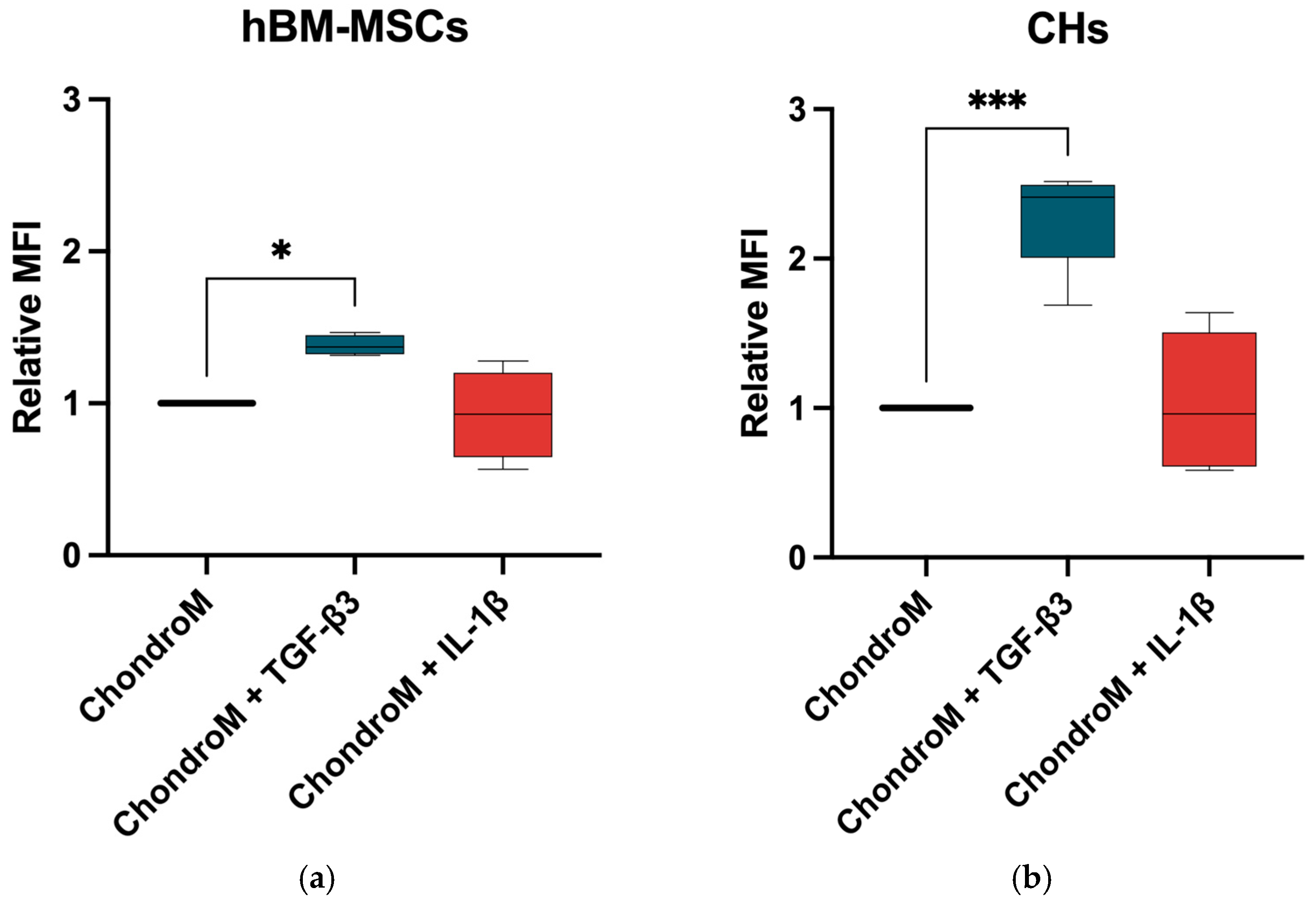
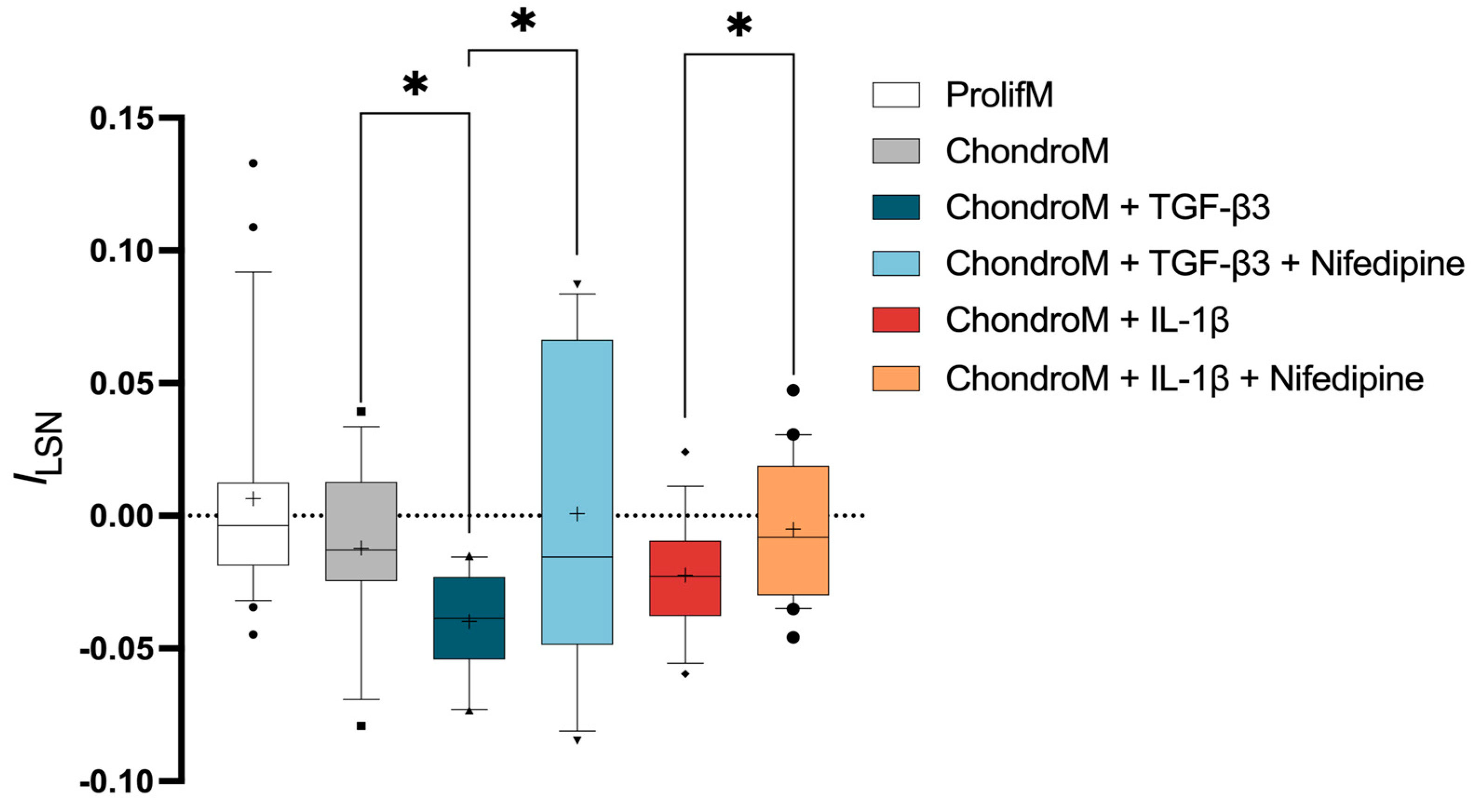
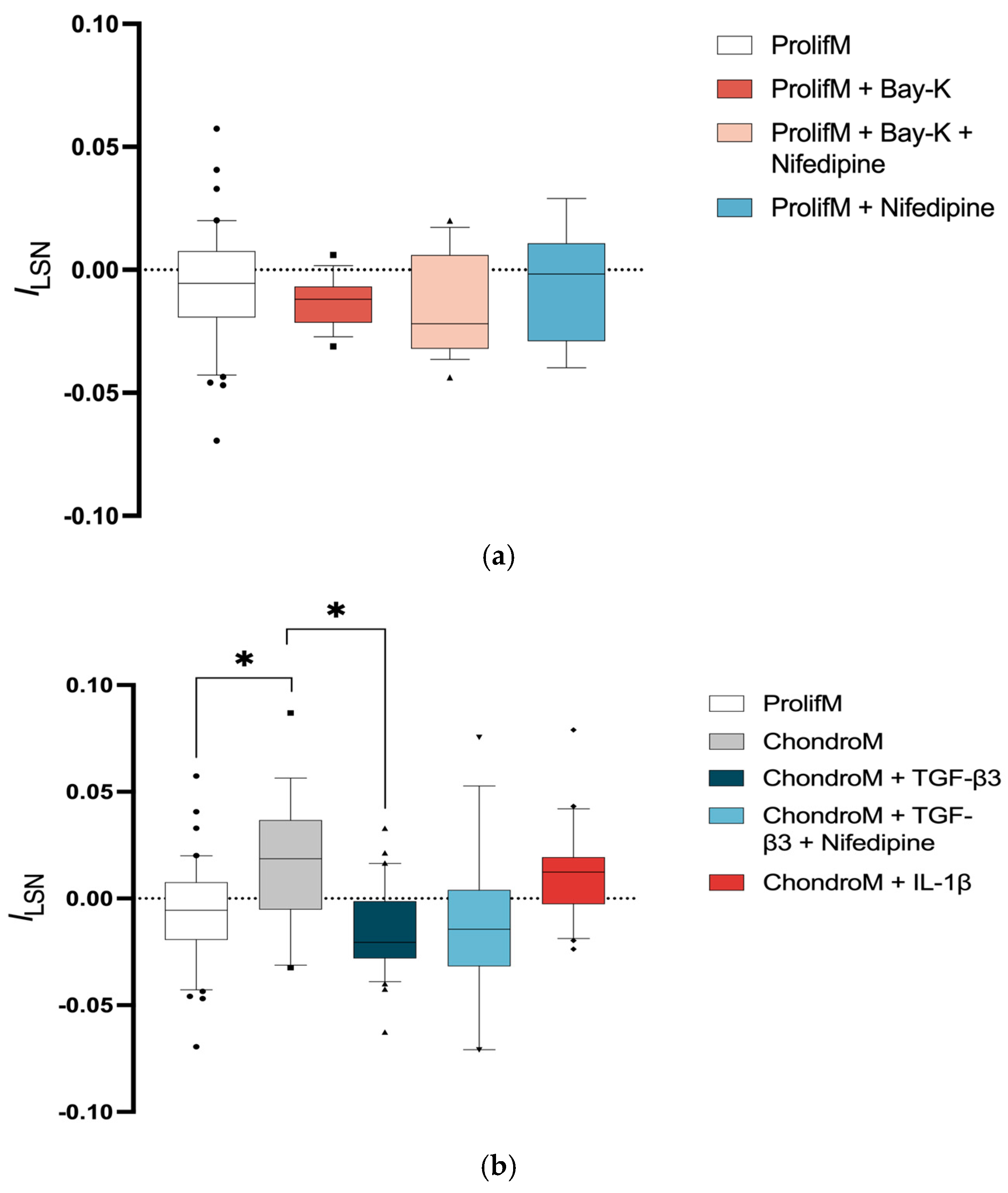
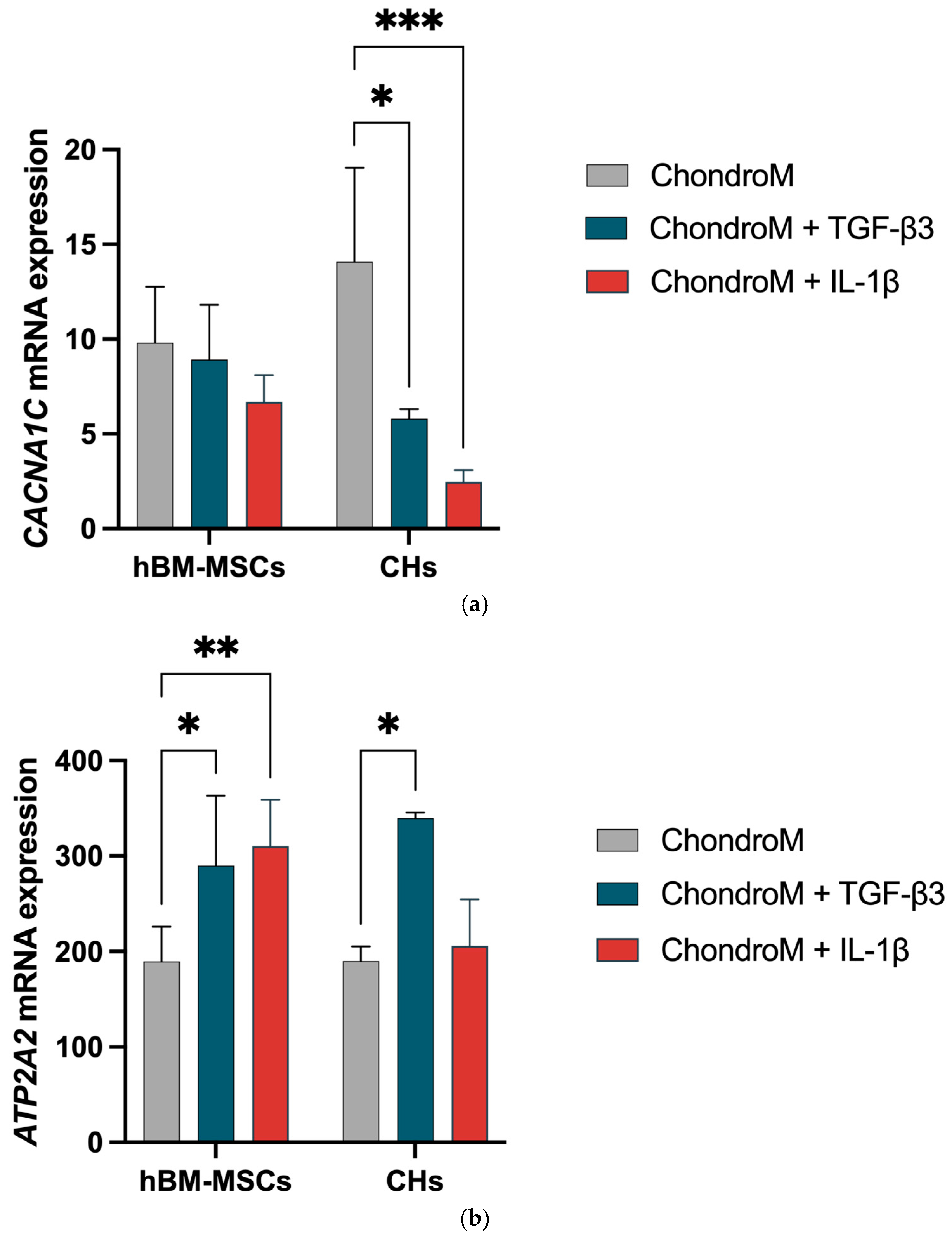
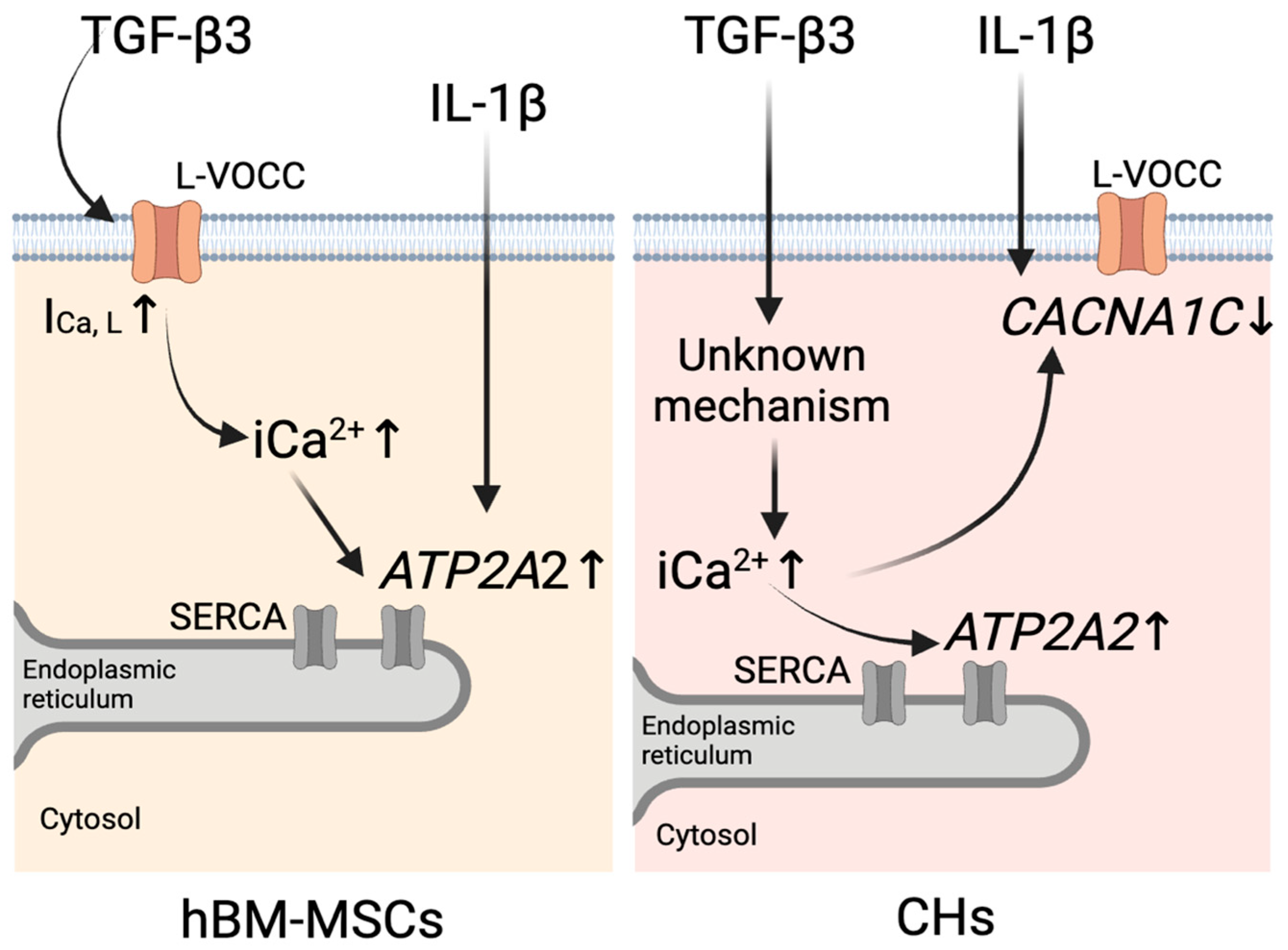
Disclaimer/Publisher’s Note: The statements, opinions and data contained in all publications are solely those of the individual author(s) and contributor(s) and not of MDPI and/or the editor(s). MDPI and/or the editor(s) disclaim responsibility for any injury to people or property resulting from any ideas, methods, instructions or products referred to in the content. |
© 2025 by the authors. Licensee MDPI, Basel, Switzerland. This article is an open access article distributed under the terms and conditions of the Creative Commons Attribution (CC BY) license (https://creativecommons.org/licenses/by/4.0/).
Share and Cite
Shelest, A.; Alaburda, A.; Vaiciuleviciute, R.; Uzieliene, I.; Bialaglovyte, P.; Bernotiene, E. The Effect of TGF-β3 and IL-1β on L-Type Voltage-Operated Calcium Channels and Calcium Ion Homeostasis in Osteoarthritic Chondrocytes and Human Bone Marrow-Derived Mesenchymal Stem Cells During Chondrogenesis. Pharmaceutics 2025, 17, 343. https://doi.org/10.3390/pharmaceutics17030343
Shelest A, Alaburda A, Vaiciuleviciute R, Uzieliene I, Bialaglovyte P, Bernotiene E. The Effect of TGF-β3 and IL-1β on L-Type Voltage-Operated Calcium Channels and Calcium Ion Homeostasis in Osteoarthritic Chondrocytes and Human Bone Marrow-Derived Mesenchymal Stem Cells During Chondrogenesis. Pharmaceutics. 2025; 17(3):343. https://doi.org/10.3390/pharmaceutics17030343
Chicago/Turabian StyleShelest, Anastasiia, Aidas Alaburda, Raminta Vaiciuleviciute, Ilona Uzieliene, Paulina Bialaglovyte, and Eiva Bernotiene. 2025. "The Effect of TGF-β3 and IL-1β on L-Type Voltage-Operated Calcium Channels and Calcium Ion Homeostasis in Osteoarthritic Chondrocytes and Human Bone Marrow-Derived Mesenchymal Stem Cells During Chondrogenesis" Pharmaceutics 17, no. 3: 343. https://doi.org/10.3390/pharmaceutics17030343
APA StyleShelest, A., Alaburda, A., Vaiciuleviciute, R., Uzieliene, I., Bialaglovyte, P., & Bernotiene, E. (2025). The Effect of TGF-β3 and IL-1β on L-Type Voltage-Operated Calcium Channels and Calcium Ion Homeostasis in Osteoarthritic Chondrocytes and Human Bone Marrow-Derived Mesenchymal Stem Cells During Chondrogenesis. Pharmaceutics, 17(3), 343. https://doi.org/10.3390/pharmaceutics17030343







